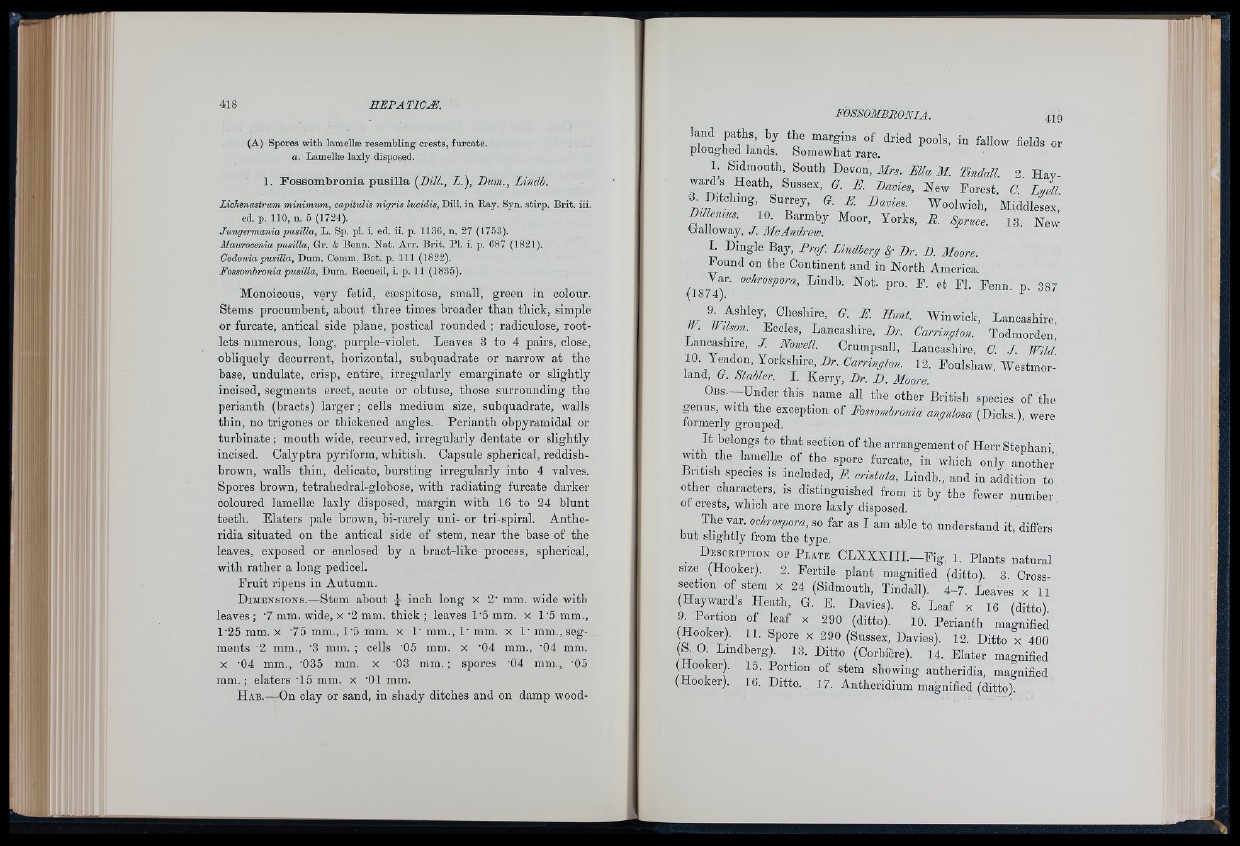
(A) Spores with lamellæ resembling crests, furcate.
a. Lamellæ laxly disposed.
1. Fossombronia pusilla (DHL, L.), Dum., Lindh.
Liehenastrum minimum,, capituLis nigris lucidis, Dili, in Ray. Syn. stirp. Brit. iii.
ed. p. 110, n. 5 (1724).
.Tungermania pusilla, L. Sp. pl. i. ed. ii. p. 1136, n. 27 (1758).
Maurocenia pusilla, Gr. <fc Benn. Nat. A ir. B rit. P l. i. p. G87 (1821).
Codonia pusiüa, Dum. Comm. Bot. p. 111 (1822).
Fossomhronia pusilla, Dum. Recueil, i. p. 11 (1835).
Monoicous, very fetid, cæspitose, small, green in colour.
Stems procumbent, about three times broader than thick, simple
or furcate, antioal side plane, postical rounded ; radiculose, rootlets
numerous, long, purple-violet. Leaves 3 to 4 pairs, close,
obliquely deourrent, horizontal, snbquadrate or narrow at the
base, undulate, crisp, entire, irregularly emarginate or slightly
incised, segments erect, acute or obtuse, those surrounding the
perianth (braots) larger; cells medium size, suhquadrate, walls
thin, no trigones or thickened angles. Perianth obpyramidal or
turbinate ; mouth wide, recurved, irregularly dentate or slightly
incised. Calyptra pyriform, whitish. Capsule spherical, reddish-
brown, walls thin, delicate, bursting irregularly into 4 valves.
Spores brown, tetrahedral-globose, with radiating furcate darker
coloured lamellæ laxly disposed, margin with 16 to 24 blunt
teeth. Elaters pale brown, bi-rarely uni- or tri-spiral. Antheridia
situated on the antioal side of stem, near the base of the
leaves, exposed or enclosed by a bract-like process, spherical,
with rather a long pedicel.
Fruit ripens in Autumn.
Dimensions.—Stem about -J- inch long x 2' mm. wide with
leaves ; '7 mm. wide, x '2 mm. thick ; leaves 1’5 mm. x I'o mm.,
1'25 mm. x '75 mm., 1'5 mm. x 1' mm., 1' mm. x 1' mm., segments
’2 mm., '3 mm. ; cells '05 mm. x "04 mm., ’04 mm.
X '04 mm., '035 mm. x '03 mm. ; spores '04 mm., '05
mm.; elaters T5 mm. x ’01 mm.
H a b .—On clay or sand, in sliady ditches and on damp woodland
paths, by the margins of dried pools, in fallow fields or
ploughed lands. Somewhat rare.
1. Sidraouth, South Devon, Mrs. Ella M. Tindall. 2. Hay-
ward s Heath Sussex, H / . Davies, New Forest, (7. Ujell.
¥ Ditching, Surrey, (7. R Davies. Woolwich, Middlesex,
miemus. 10. Barmby Moor, Torks, H. Spruce. 13. New
Dalloway, f McAndreio,
I. Dingle Bay, Prof. Lindberg fl Br. D. Moore.
Found on the Continent and in North America
{ 1 8 7 l r Fl. Fenn. p. 387
ft Ashley Cheshire, (7. K Hunt. Winwick, Lancashire,
W. Wilson. Eccles, Lancashire, Dr. Carrington. Todmorden,
Lancashire, J. Nowell. Crumpsall, Lancashire, C. J. Wild.
10. Y^idon, Yorkshire, Dr. Carrington. 12. Foulshaw, Westmor-
land, G. Stahler, I. Kerry, Br. D. Moore.
CBS.---Under this name all the other British species of the
genus, with the exception of Fossombronia angulosa (Dicks.), were
lormerly grouped.
I t belongs to that section of the arrangement of Herr Stephani
with the lamellæ of the spore furcate, in which only anothei-
British species is included, P. cristata, Lindb., and in addition to
other charaoters, is distinguished from it by the fewer number
ot crests, which are more laxly disposed.
The var. ochrospora, so far as I am able to understand it, differs
but slightly from the type.
_ D e sc rip tio n oe P l a t e C L X X X III.-F ig . 1. Plants natural
size^ (Hooker). 2. Fertile plant magnified (ditto). 3. Cross-
action of stem X 24 (Sidmouth, Tindall). 4-7. Leaves x 11
(Hayward’s Heath, G. E. Davies). 8. Leaf x 16 (ditto)
/ P c irtis of leaf x 290 (ditto). 10. Perianth magnified
Hooker). 11. Spore x 290 (Sussex. Davies). 12. Ditto x 400
H 0. Lindberg). 13. Ditto (Corbière). 14. Elater magnified
( ooker). 15. Portion of stem showing antheridia, magnified
(Hooker). 16. Ditto. 17. Antheridium magnified (ditto).